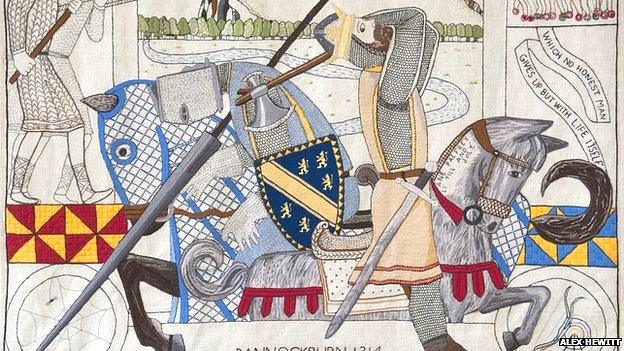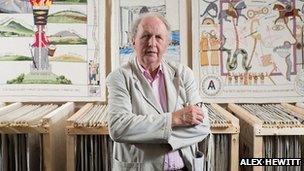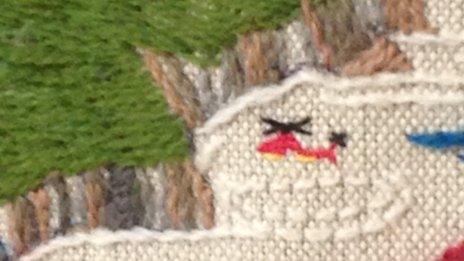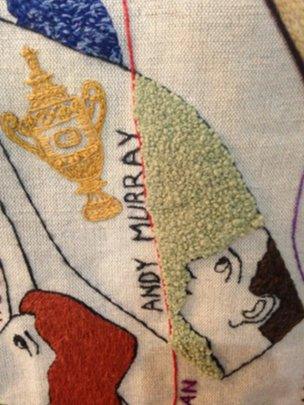The making of the Great Tapestry of Scotland
- Published
It's called The Great Tapestry of Scotland - and no wonder - it's the world's longest.
It's taken 1,000 volunteer stitchers more than 50,000 hours - and enough yarn to scale Ben Nevis 74 times.
After a year in the making, The Great Tapestry of Scotland has been unveiled.
It breaks the record for the longest embroidered tapestry in the world - at 143m, it is 70m longer than the famous Bayeaux Tapestry in Normandy.
From the Battle of Bannockburn to the reconvening of the Scottish Parliament in 1999, it tells the "story of Scotland" in 160 intricate panels.
But how do you squeeze 12,000 years of Scottish history into one tapestry?
Through a "glorious process of ruthless editing", says historian Alastair Moffat.

From the Battle of Bannockburn to Dolly the Sheep, the tapestry chronicles 12,000 years of Scottish history
"Pitfalls open on every side. One of the deepest is the military option, our history as a series of invasions, wars and battles, many of them grey defeats.
"Most important have been our efforts to make a tapestry that distils Scotland's unique sense of herself, to tell a story only of this place, and without bombast, pomp or ceremony, to ask the heart-swelling rhetorical question: Wha's like us?"
Writer Alexander McCall Smith, creator of the The No. 1 Ladies' Detective Agency series, had the original idea for the tapestry.
"[Tapestry] is such a vivid and immediate art form," he said.
"It occurred to me it would be a very good idea to have a tapestry depicting the whole history of Scotland.
"Everybody was inspired and eager to begin. And now we have this truly remarkable work of art."
Dubbed the "people's tapestry", public suggestions and open debates were held to decide the question of what should be included - and what should be left out.

Author Alexander McCall Smith had the idea of a giant tapestry to tell the story of Scotland
Artist Andrew Crummy designed each panel, which were then traced onto Scottish linen ready to be sewn.
Thread of a story
While each panel is based on a moment in history, eagle-eyed viewers may spot a few anachronistic details in some of the panels.
The panel dedicated to James Clerk Maxwell, who did revolutionary work on electricity and magnetism, includes a TV and a mobile phone in his beard.
Hundreds of stitching groups, from the Islands to the Borders, undertook the painstaking work of embroidering the design into being.
Each panel took more than 400 hours to complete.

Susie Finleyson stitched a helicopter into her panel in tribute to people involved in Super Puma accidents, including her husband
Many of the stitchers had personal connections to their piece of the story, such as Susie Finleyson, from Midlothian.
She added a tiny embroidered helicopter floating in the sea to her panel - which depicts the history of Fair Isle knitting.
It marks the spot where her husband, a subsea engineer, survived a Super Puma crash last October.
She said: "It was a horrendous experience. Not knowing if he was involved, then not knowing if he was ok or not...
"I was very lucky I got Bruce home. My heart goes out to the families of those who died recently.
"Sewing a helicopter into the tapestry is a modern tribute in a traditional panel, and I hope it will be there for hundreds of years to come."
One woman modelled a miner character on her husband - complete with his distinctive five o'clock shadow.
Another discovered her family's ancestral connections to whaling ships through researching the history of the panel she was working on.
Organisers say the army of stitchers has been made up largely of women - there are 40 stitchers called Margaret.
However, volunteers have ranged from four to 94-years-old, from every walk of life, many of whom had never sewn before. One panel was made by an all-male group.
'Tug of war'
Anna Renz was one of a group of book publishers who stitched a panel depicting the foundation of the Scottish universities.

Wimbledon champion Andy Murray made a last minute addition to the tapestry
"Obviously it's very difficult to all work on it at exactly the same time, it would be a big tug of war. So what we usually did was pass it from person to person.
"We were stitching in our lunch hours, people would take it home, I often jogged to work with it in my backpack...although our head stitcher would hate me saying that.
"It went on some journey."
And although today marks the official unveiling of the Great Tapestry of Scotland, the story does not end here.
Andy Murray and his Wimbledon trophy have already been tagged on.
And organisers say there is "plenty of scope for it to grow and evolve" with the referendum on Scottish Indepedence and the Glasgow Commonwealth Games next year.
After it has been on display in Holyrood, the intention is to tour the tapestry through Scotland, the rest of the UK and overseas to America and Canada.
The Great Tapestry of Scotland, external will be on public display at Scottish Parliament, external until 21 September.
- Published23 March 2012